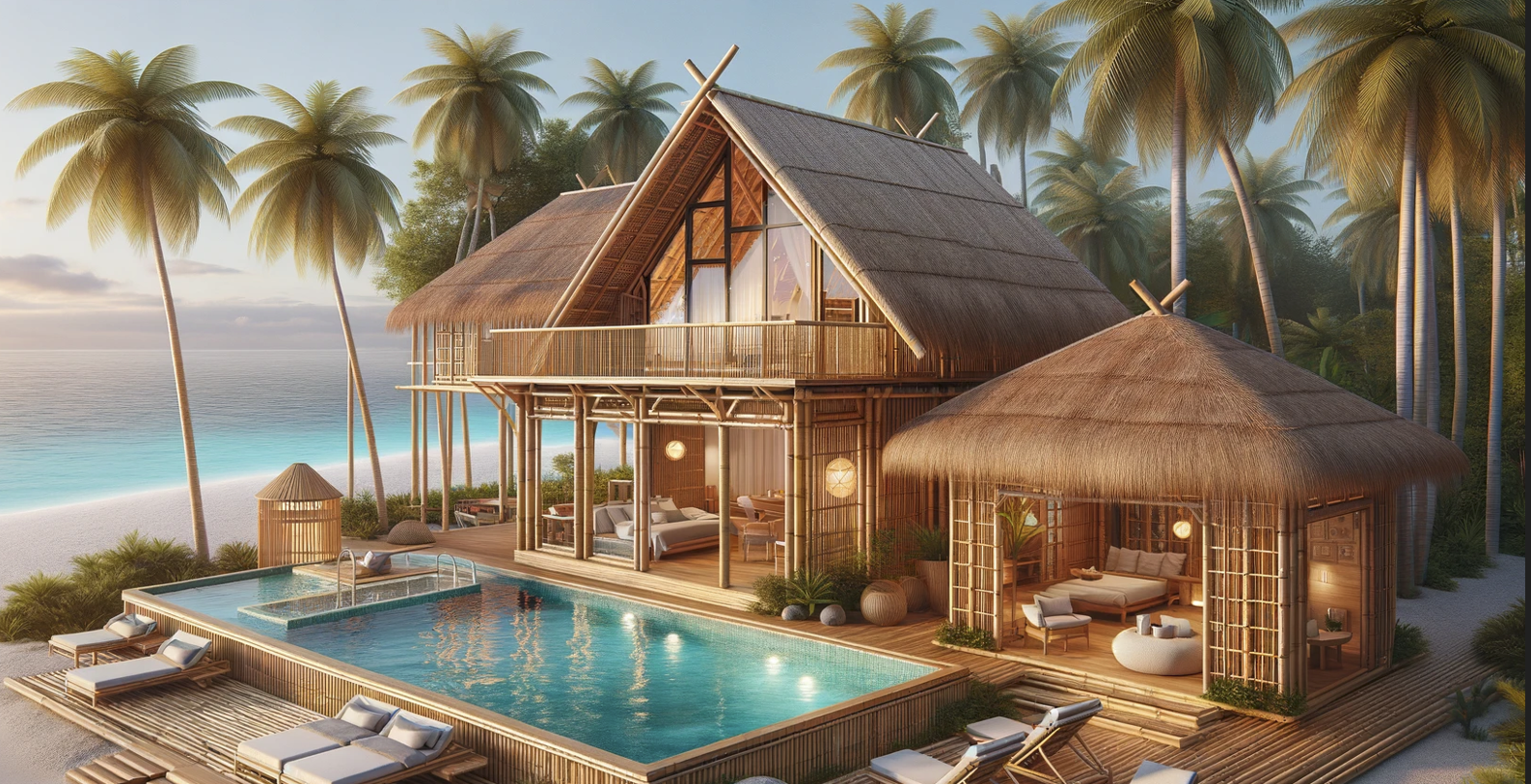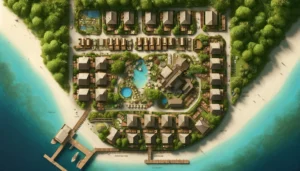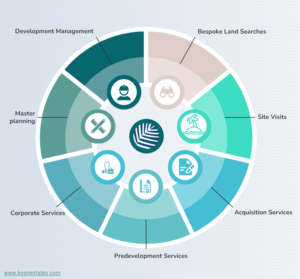
Private Island Developments – Concepts and Considerations
Creating an eco-resort on a private island is an exciting project, especially for first-time developers. The vision of a sustainable haven nestled in untouched nature is compelling, but understanding the costs involved, particularly in the construction phase, is crucial for turning this vision into a reality. This article will delve into the various costs you need to consider when developing an eco-resort on a private island, providing insights and guidance to help you successfully navigate this process.
Private Island Developments – Concepts and Considerations – Define Your Vision and Objectives
Begin by clearly defining the vision and objectives of your resort. What type of resort are you building? Who is your target audience? What unique features and
amenities will your resort offer? Having a clear vision will guide all subsequent planning and design efforts.
Acquire Site Data
Check the bathymetry and topography of your site and ensure your selected site is suitable for your resort concept and size. Get surveys completed to assist with creating an accurate master plan. In the case of some sites, Kepri Estates may be able to negotiate access to the site prior to closing on a sale, saving valuable time in your predevelopment and design stages.
Create a Master Plan
The master plan serves as a comprehensive blueprint for your resort development. It outlines the layout of all structures, amenities, and infrastructure. Ensure that the master plan includes detailed designs for guest accommodations, dining areas, recreational facilities, and landscaping. Consider sustainable practices to minimize environmental impact and appeal to eco-conscious travellers.
Incorporate Detailed Designs
Develop detailed architectural designs for each component of the resort. These designs should include floor plans, elevations, and 3D renderings. Detailed designs provide a clear picture of the final product and help in accurate cost estimation.
Estimate Costs with Precision
With detailed plans, designs, and a bill of quantities (BoQ) in hand, work with your contractors and quantity surveyors to estimate construction costs accurately. This should include costs for materials, labour, permits, and contingencies. Having precise cost estimates helps in securing financing and avoiding budget overruns.
Private Island Developments – Concepts and Considerations – Site Preparation and Infrastructure Development
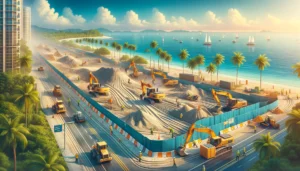
Before construction can begin, significant work is needed to prepare the site and develop basic infrastructure. This phase is critical as it lays the foundation for all subsequent construction activities.
Clearing and Grading
This involves removing existing vegetation, leveling the land, and preparing the ground for construction. The cost will depend on the size and topography of the island, as well as the density of vegetation. Special equipment and labour will be required, and in some cases, environmentally friendly methods must be employed to preserve the natural habitat.
Soil Testing and Stabilization
Conducting soil tests to assess suitability for building and implementing stabilization measures if necessary is essential. This may include the addition of organic or inorganic materials to improve soil strength and stability, which ensures the safety and durability of the structures.
Roads and Pathways
Constructing access roads and internal pathways to facilitate the movement of materials and personnel is crucial. The design of these roads must consider the island’s natural contours to minimize environmental impact and maintain aesthetic appeal. Additionally, sustainable materials like recycled asphalt or permeable paving stones can be used.
Dock or Pier Construction
Building docking facilities to enable the transport of construction materials and equipment by sea is often necessary for isolated islands. This involves constructing sturdy piers or floating docks, which can be a significant investment. The choice of materials and construction techniques should ensure durability against harsh marine conditions.
Temporary Facilities
Setting up temporary storage, housing, and offices for construction crews is another important step. These facilities must be designed to minimize environmental impact and can often be repurposed or removed after the construction phase. Using modular and prefabricated structures can reduce costs and construction time.
Services Prelay
Excavating trenches in preparation for laying services like power, potable water, communications and wastewater management for the resort.
Private Island Developments – Concepts and Considerations – Sustainable Building Materials
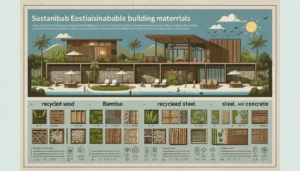
Choosing sustainable building materials is a cornerstone of eco-resort development. These materials not only reduce environmental impact but also enhance the resort’s appeal to eco-conscious travellers. By prioritizing sustainability in construction, developers can create resorts that are both environmentally friendly and attractive to guests seeking a green vacation experience.
Recycled and Reclaimed Wood
Using wood from sustainable sources or reclaimed from old structures is an eco-friendly option that significantly reduces deforestation. Reclaimed wood offers a unique aesthetic appeal, adding character and history to the buildings. This material is versatile and can be used for framing, flooring, and decorative elements. By repurposing old wood, developers can reduce the need for new lumber, thus conserving forests and promoting a circular economy.
Bamboo
Bamboo is a rapidly renewable resource that is ideal for various construction applications, including flooring, panelling, and furniture. Its fast growth rate, strength, and flexibility make it a sustainable alternative to traditional hardwoods. Bamboo has a low carbon footprint, as it absorbs more carbon dioxide and produces more oxygen than many other plants. Additionally, bamboo plantations help prevent soil erosion and restore degraded lands. Its use in eco-resorts not only supports environmental sustainability but also provides a modern and stylish look.
Recycled Steel and Concrete
Utilising recycled materials such as steel and concrete is becoming increasingly popular in sustainable construction. Recycled steel can be used for structural components, providing the same strength and durability as new steel but with a significantly lower environmental impact. Incorporating recycled aggregates into concrete reduces the need for virgin materials, lowering the carbon footprint of construction projects. These materials contribute to sustainability by diverting waste from landfills and reducing the demand for new raw materials.
By integrating these sustainable building materials into the design and construction of eco-resorts, developers can create structures that are not only durable and aesthetically pleasing but also environmentally responsible. This approach not only aligns with the values of eco-conscious travellers but also supports global efforts to promote sustainable development and reduce the environmental impact of the construction industry.
Private Island Developments – Concepts and Considerations – Construction of Eco-Friendly Buildings
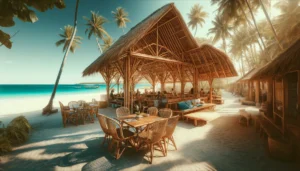
The construction of eco-friendly buildings involves various techniques and practices designed to minimize environmental impact while maximizing energy efficiency and comfort.
Passive Solar Design
Orienting buildings to maximize natural light and heat during winter while minimizing heat gain in summer can significantly reduce energy costs. Large windows, thermal mass, and strategic shading are key elements of passive solar design.
Insulation and Ventilation
Using high-quality insulation materials and incorporating natural ventilation helps reduce reliance on artificial heating and cooling systems. Insulation materials can include recycled cellulose, wool, or other sustainable options. Proper ventilation ensures indoor air quality and comfort.
Rainwater Harvesting
Installing systems to collect and store rainwater for use in irrigation, laundry, and toilets is a sustainable practice. Rainwater can be filtered and treated to meet potable water standards, reducing the resort’s reliance on local water sources.
Greywater Recycling
Implementing systems to recycle water from showers and sinks for use in landscaping and non-potable applications can significantly reduce water consumption. Greywater systems require careful design to ensure safety and efficiency.
Low-Flow Fixtures
Installing low-flow faucets, showers, and toilets reduces water consumption without compromising guest comfort. These fixtures are designed to use less water while maintaining performance, contributing to overall water conservation efforts.
Solar Panels
Installing photovoltaic panels to generate electricity from sunlight is a clean and renewable energy source. Solar panels can be mounted on roofs or in ground-mounted arrays, providing a significant portion of the resort’s energy needs.
Biomass Boilers
Using organic materials such as wood pellets to generate heat for the resort is a sustainable heating option. Biomass boilers are efficient and can utilize local resources, reducing reliance on fossil fuels.
Private Island Developments – Concepts and Considerations – Building Guest Accommodations
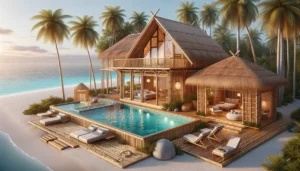
Guest accommodations are the heart of any resort. In an eco-resort, these structures must blend seamlessly with the natural environment while providing comfort and luxury. There are several types of accommodations that are particularly well-suited for eco-resorts
Eco-Friendly Cabins
Using sustainable materials and energy-efficient designs to create comfortable and attractive cabins is a popular choice. These cabins can be prefabricated to reduce construction time and environmental impact. Key features of eco-friendly cabins include:
1. Sustainable Materials: Reclaimed wood, bamboo, and other eco-friendly materials.
2. Energy Efficiency: Solar panels, rainwater harvesting systems, and natural ventilation.
3. Comfort and Luxury: Modern amenities, comfortable furnishings, and aesthetic designs.
Treehouses
Building treehouses provides guests with a unique perspective of the natural surroundings. These structures must be carefully designed to avoid damaging trees and ensure safety. Treehouses can be made from sustainable materials and incorporate eco-friendly features. Key features of treehouses include:
1. Unique Experience: Elevated views and a close connection with nature.
2. Sustainable Construction: Using reclaimed wood and other sustainable materials.
3. Eco-Friendly Features: Solar power, rainwater harvesting, and composting toilets.
Luxury Bamboo Villas
Luxury bamboo villas offer an elegant and sustainable lodging option, combining modern comforts with eco-friendly practices. Bamboo is a rapidly renewable resource, making it an excellent material for eco-resort construction. Key features of luxury bamboo villas include:
1. Sustainable Elegance: High-quality bamboo construction that blends luxury with sustainability.
2. Natural Cooling: Open designs and natural ventilation to keep interiors cool without excessive energy use.
3. Modern Conveniences: Stylish interiors with modern amenities such as Wi-Fi, air conditioning, and premium bedding.
Each of these accommodation types offers a unique experience for guests while emphasizing sustainability and environmental responsibility. By integrating these eco-friendly lodging options, developers can create an eco-resort that not only delights guests but also respects and preserves the natural beauty of its surroundings.
Private Island Developments – Concepts and Considerations – Interior Design and Furnishing
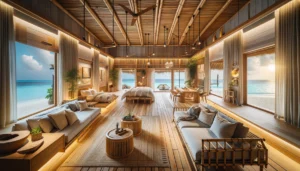
Creating a sustainable interior design for an eco-resort not only helps in reducing the environmental impact but also enhances the guest experience. Incorporating eco-friendly materials and energy-efficient systems can significantly contribute to the resort’s overall sustainability.
Sustainable Furniture
Choosing furniture made from reclaimed wood, bamboo, or other sustainable materials is essential for maintaining the resort’s eco-friendly ethos. Custom-designed pieces can enhance the aesthetic appeal and guest experience. Reclaimed wood furniture adds character and a sense of history to the interiors, while bamboo furniture is lightweight, durable, and has a minimal environmental footprint. Additionally, considering furniture made from recycled plastic or metal can further reduce waste and promote circular economy principles.
Eco-Friendly Textiles
Using organic cotton, linen, and other natural fibres for bedding, curtains, and upholstery contributes to sustainability. These materials are free from harmful chemicals and provide a healthy indoor environment. Organic textiles are produced without synthetic pesticides or fertilizers, making them safer for both the environment and the people involved in their production. Furthermore, using locally sourced textiles can reduce the carbon footprint associated with transportation and support the local economy.
Energy-Efficient Lighting
Installing LED lighting and incorporating natural light reduces energy consumption and enhances the ambiance. LED lights are long-lasting and consume significantly less energy compared to traditional incandescent bulbs. Smart lighting systems can adjust brightness based on occupancy and natural light levels, further optimizing energy use. Incorporating skylights and large windows can maximize natural light, reducing the need for artificial lighting during the day and creating a bright, inviting atmosphere.
Water-Efficient Fixtures
Integrating water-efficient fixtures, such as low-flow faucets, showerheads, and dual-flush toilets, can greatly reduce water consumption. These fixtures maintain performance while using less water, contributing to the conservation of this vital resource. Greywater recycling systems can be implemented to reuse water from sinks and showers for irrigation or flushing toilets, further enhancing water efficiency.
Sustainable Flooring
Choosing sustainable flooring options such as bamboo, cork, or reclaimed wood can add to the eco-friendly credentials of the resort. These materials are not only sustainable but also durable and aesthetically pleasing. Additionally, natural fibre carpets made from wool or sisal can provide a luxurious feel while being environmentally responsible.
By integrating these concepts into the interior design of an eco-resort, developers can create a luxurious, comfortable, and sustainable environment that appeals to eco-conscious travellers. This approach not only enhances the guest experience but also aligns with global efforts to promote sustainability and environmental stewardship.
Private Island Developments – Concepts and Considerations – Dining and Common Areas
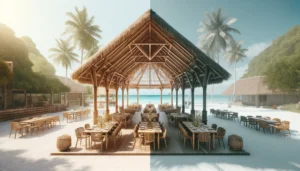
The construction of dining and common areas requires careful planning to ensure these spaces are both functional and environmentally friendly.
Energy-Efficient Appliances
Using high-efficiency appliances in the kitchen reduces energy consumption and operating costs. These appliances are designed to perform optimally while using less electricity and water.
Local and Sustainable Materials
Building dining areas with locally sourced, sustainable materials reduces transportation emissions and supports the local economy. Using materials like locally quarried stone, reclaimed wood, and bamboo adds to the resort’s authenticity.
Waste Reduction Systems
Implementing systems to compost food waste and recycle materials used in the kitchen is crucial for maintaining sustainability. Composting organic waste reduces landfill use and produces valuable compost for landscaping.
Common Areas
Natural Ventilation
Designing open-air lounges and common areas to take advantage of natural ventilation improves air quality and reduces energy use. Using operable windows, skylights, and strategically placed openings enhances airflow.
Eco-Friendly Furnishings
Furnishing common areas with sustainably sourced or recycled materials aligns with the resort’s environmental goals. Comfortable and stylish furniture made from eco-friendly materials enhances the guest experience.
Recreational Facilities
Constructing swimming pools, spas, and gyms with energy-efficient equipment and sustainable materials ensures these amenities are both luxurious and eco-friendly. Using solar heating for pools and energy-efficient exercise equipment minimizes environmental impact.
Private Island Developments – Concepts and Considerations – Landscaping and Environmental Restoration
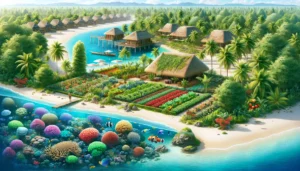
Landscaping and environmental restoration are crucial for enhancing the resort’s aesthetic appeal and supporting local ecosystems.
Indigenous Flora
Planting native trees, shrubs, and flowers supports local wildlife and reduces water usage. Native plants are adapted to the local climate and soil, requiring less maintenance and providing habitat for native species.
Edible Gardens
Creating organic vegetable and herb gardens to supply the resort’s kitchen with fresh produce enhances sustainability. These gardens can be integrated into the landscape design and provide guests with a farm-to-table experience.
Habitat Restoration
Restoring any degraded wetlands supports biodiversity and manages stormwater runoff. Wetlands act as natural water filters and provide habitat for a variety of species.
Coral Reef Conservation
Implementing measures to protect and restore coral reefs, if applicable to the island’s location, is essential for marine biodiversity. Efforts may include establishing marine protected areas, reducing pollution, and promoting sustainable tourism practices.
Drip Irrigation Systems
Installing drip irrigation systems minimizes water use and delivers water directly to plant roots. This method is highly efficient and reduces evaporation and runoff.
Mulching
Using organic mulch to retain soil moisture and reduce the need for irrigation is a simple yet effective technique. Mulching also suppresses weeds and improves soil health.
Private Island Developments – Concepts and Considerations – Renewable Energy Systems
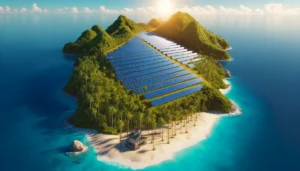
Implementing renewable energy systems is a cornerstone of any eco-resort, providing sustainable and cost-effective energy solutions. These systems not only reduce the resort’s carbon footprint but also enhance its appeal to environmentally conscious travellers.
Solar Panels
Installing solar panels on rooftops or ground-mounted systems generates electricity from sunlight. Solar power is a clean and renewable energy source that can significantly reduce the resort’s carbon footprint. By harnessing the abundant sunlight in tropical locations, eco-resorts can power various operations sustainably.
Solar Water Heaters
Using solar thermal systems to heat water for guest rooms and common areas is an efficient and sustainable option. Solar water heaters can provide a consistent supply of hot water while reducing energy costs. This method minimizes reliance on traditional energy sources and supports the resort’s commitment to green energy.
Biomass Boilers
Using organic waste materials to generate heat for the resort’s heating and hot water systems is a sustainable option. Biomass boilers can utilize locally sourced materials, reducing transportation emissions. This approach not only manages waste effectively but also provides a renewable energy source.
Green Energy-Powered Water Desalination
In isolated locations, access to fresh water can be a challenge. Green energy-powered water desalination systems offer an eco-friendly solution. These systems use renewable energy sources, such as solar or wind power, to convert seawater into potable water. Solar-powered desalination units harness sunlight to drive the desalination process, ensuring a sustainable and reliable water supply. Wind-powered systems can be used in windy regions to achieve the same goal. This approach not only provides a vital resource but also aligns with the resort’s sustainable practices.
By integrating these renewable energy systems, an eco-resort can operate efficiently while minimizing its environmental impact. These green technologies ensure that the resort remains sustainable and attractive to eco-conscious travellers, promoting a model of responsible tourism and environmental stewardship.
Private Island Developments – Concepts and Considerations – Waste Management Systems
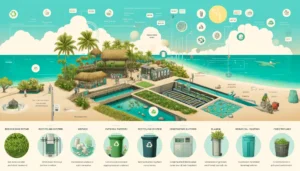
Effective waste management is essential for maintaining the ecological integrity of the island and reducing the resort’s environmental impact. By adopting comprehensive waste management strategies, eco-resorts can minimize their footprint and promote sustainable practices.
Composting
Implementing composting systems for organic waste from kitchens and landscaping reduces landfill use and produces valuable compost for gardening. Composting also reduces greenhouse gas emissions from waste decomposition. The compost generated can enrich the soil in the resort’s gardens, supporting local food production and enhancing the landscape.
Recycling Programs
Establishing recycling programs for paper, plastics, glass, and metals is crucial for minimizing waste. Clear signage and convenient recycling stations encourage guests and staff to participate. Recycling not only conserves resources but also reduces the energy required to produce new materials, contributing to overall sustainability efforts.
Biological Treatment Systems
Implementing biological treatment systems to process and purify wastewater ensures that water is treated effectively and sustainably. These systems use natural processes to break down contaminants and can be integrated into the landscape design, adding to the resort’s aesthetic appeal while supporting environmental health.
Blackwater for Subsurface Irrigation and Fertilisation
Treated blackwater can be used for subsurface irrigation and fertilization, providing a sustainable solution for waste disposal and agricultural needs. By using blackwater for irrigation, resorts can reduce the need for chemical fertilizers and conserve freshwater resources. This practice also enhances soil fertility and promotes healthy plant growth, contributing to a lush and vibrant landscape.
Incineration: Using incineration for non-recyclable waste, with energy recovery systems to capture heat for use in the resort, is an option for reducing landfill use. However, incineration should be carefully managed to minimize emissions and environmental impact. Advanced incineration technologies can convert waste into energy, providing a renewable power source for the resort.
Landfill Minimisation
Reducing the amount of waste sent to landfills through effective waste reduction and recycling programs is essential. Strategies include source separation, composting, and encouraging guests to minimize waste. Educating guests about the resort’s waste management practices can foster a culture of sustainability and enhance their overall experience.
By integrating these waste management strategies, eco-resorts can significantly reduce their environmental impact and promote a more sustainable future. Effective waste management not only preserves the natural beauty of the island but also aligns with global efforts to combat climate change and protect our planet.
Private Island Developments – Concepts and Considerations – Communication and Technology Infrastructure
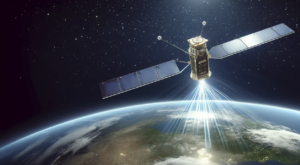
Developing a reliable and sustainable communication and technology infrastructure is essential for the smooth operation of the resort and enhancing the guest experience. In today’s digital age, guests expect seamless connectivity and efficient technology solutions, even in remote locations. Here’s how to ensure your eco-resort meets these needs:
Internet and Wi-Fi
Installing high-speed internet and Wi-Fi systems throughout the resort is necessary for guest satisfaction and operational efficiency. These systems should be designed to minimize energy use and provide reliable coverage. With the advent of Starlink, a satellite internet constellation developed by SpaceX, providing high-speed internet to remote islands has become a cost-effective and practical solution. Starlink’s low-latency broadband internet ensures that guests can enjoy uninterrupted streaming, browsing, and communication, while resort operations benefit from consistent connectivity.
Telecommunication
Setting up telephone and radio communication systems for staff and guest use ensures safety and coordination. These systems should be integrated with emergency response plans and support seamless communication across the resort. Reliable telecommunication infrastructure is crucial for managing day-to-day operations and handling emergencies efficiently.
Smart Energy Management
Implementing smart energy management systems to monitor and optimize energy use helps reduce costs and environmental impact. These systems can track energy consumption, identify inefficiencies, and automate energy-saving measures. By using smart technology, resorts can enhance their sustainability efforts and reduce operational expenses.
Guest Services Technology
Using mobile apps and digital platforms for reservations, check-ins, and guest services enhances the guest experience and reduces paper use. These technologies can streamline operations and provide personalized services. Mobile apps can offer guests information about resort activities, dining options, and local attractions, improving their overall stay.
Security Systems
Installing advanced security systems, including surveillance cameras and access control systems, ensures the safety of guests and staff. These systems should be designed to protect privacy and integrate with the resort’s overall security plan. Modern security technologies can help prevent unauthorized access and ensure quick responses to any security incidents.
By incorporating these communication and technology solutions, eco-resorts can provide a seamless and enjoyable experience for guests while maintaining operational efficiency and sustainability. The integration of Starlink for internet connectivity, in particular, offers a reliable and innovative solution to the challenges of remote island locations, ensuring that both guests and staff stay connected and informed.
Project Management and Labour Costs
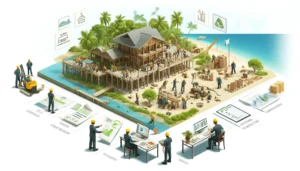
Effective project management and skilled labour are crucial for the successful construction of an eco-resort. This process involves coordinating various teams, managing timelines, and ensuring quality control, all of which contribute to maintaining high standards and sustainability.
Project Managers
Hiring experienced project managers to oversee the construction process, manage budgets, and coordinate contractors is essential. These professionals ensure that the project stays on schedule and within budget while maintaining quality and sustainability standards. Their expertise helps navigate the complexities of eco-friendly construction, balancing environmental considerations with practical building requirements.
Construction Schedules
Developing detailed construction schedules is critical for managing costs and resources. These schedules should be comprehensive, accounting for potential delays and including contingency plans. A well-structured timeline ensures that all phases of the project are completed efficiently, minimizing downtime and avoiding cost overruns.
Quality Control
Implementing robust quality control measures ensures high construction standards and adherence to eco-friendly practices. Regular inspections, audits, and testing help identify issues early, allowing for prompt corrections. This proactive approach maintains the integrity of the construction process and ensures that sustainability goals are met.
Skilled Labour
Hiring skilled workers, such as carpenters, electricians, plumbers, and masons, experienced in sustainable building practices is crucial. While skilled labour may command higher wages, their expertise ensures quality and efficiency, ultimately reducing long-term costs by minimizing errors and rework.
Training Programs
Providing training for construction workers on eco-friendly techniques and safety protocols is essential. Training programs ensure that all team members are knowledgeable and capable of implementing sustainable practices. Well-trained workers are more efficient and produce higher-quality work, contributing to the project’s overall success.
Labour Welfare
Ensuring good working conditions, fair wages, and adequate housing for construction workers is vital for maintaining morale and productivity. Providing amenities such as health care, dining facilities, and recreation areas supports worker well-being. Happy and healthy workers are more productive and engaged, leading to lower turnover rates and fewer delays, which in turn helps keep operational costs low.
By focusing on effective project management and prioritizing labour welfare, eco-resort developers can ensure the successful and cost-effective completion of their projects. This approach not only supports sustainable construction practices but also enhances worker satisfaction and efficiency, ultimately contributing to the resort’s long-term success.
Private Island Developments – Concepts and Considerations – Contingency Planning
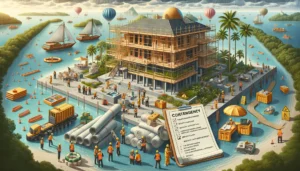
Despite careful planning, unexpected challenges can arise during the construction phase. Setting aside contingency funds is essential for addressing unforeseen issues and ensuring the project stays on track.
Weather Delays
Adverse weather conditions can significantly impact construction schedules and budgets. In tropical regions, for instance, unexpected storms or prolonged rainy seasons can halt work, damage materials, and create unsafe working conditions. To mitigate these risks, it is crucial to develop strategies for dealing with extreme weather events. This might include scheduling flexibility to account for lost days, reinforcing structures against weather damage, and ensuring proper drainage systems to handle heavy rainfall
Material Shortages
Shortages or delays in the delivery of building materials can disrupt construction progress. To manage these risks, it is important to establish reliable supply chains, maintain adequate inventory, and have alternative suppliers ready. Advanced planning and regular communication with suppliers can help anticipate and mitigate potential shortages. Utilizing locally sourced materials where possible can also reduce dependency on long-distance supply chains and support local economies.
Design Changes
Flexibility in design is essential to accommodate unforeseen site conditions or regulatory changes. During construction, it is not uncommon to encounter unexpected geological features, environmental concerns, or regulatory requirements that necessitate design modifications. These changes must be managed carefully to minimize disruption and costs. Maintaining open communication channels with architects, engineers, and regulatory bodies can help address these issues promptly and efficiently.
Cost Overruns
Including a contingency allowance in the budget helps prepare for potential cost overruns. This financial buffer provides the flexibility to address unexpected expenses without compromising the project’s overall viability. Cost overruns can arise from various sources, including price increases for materials, labour shortages, or additional work required due to unforeseen conditions. A well-managed contingency fund ensures that these additional costs do not derail the project.
Emergency Funds
Setting aside funds for emergencies or critical issues that may arise during construction is a prudent measure. These funds can cover unforeseen repairs, equipment failures, or other urgent needs that might otherwise stall the project. Having emergency funds readily available ensures that the project can continue smoothly even when unexpected challenges occur.
By anticipating potential challenges and setting aside contingency funds, developers can navigate the complexities of construction with greater confidence and resilience. This proactive approach helps ensure that the project remains on schedule and within budget, ultimately leading to a successful and sustainable eco-resort development.
Private Island Developments – Concepts and Considerations – Conclusion
Building an eco-resort on an isolated private island is a complex and rewarding endeavour. Understanding the various construction-related costs involved is crucial for first-time developers to plan effectively and ensure the success of their project. From site preparation and sustainable building materials to renewable energy systems and waste management, each aspect of construction requires careful consideration and financial investment.
By prioritising sustainability, leveraging technology, and engaging skilled professionals, you can create a luxurious and environmentally responsible eco-resort that attracts guests and contributes positively to the natural surroundings. Careful planning, effective project management, and a commitment to eco-friendly practices will help you turn your vision into a reality, offering guests an unforgettable experience in harmony with nature.
Final Tips for First-Time Developers
Prioritise Sustainability: Embrace sustainable building practices and materials at every stage of construction.
Engage Experts: Work with experienced architects, contractors, and consultants to ensure high-quality results.
Plan for Contingencies: Set aside contingency funds to address unexpected challenges and keep the project on track.
Focus on the Guest Experience: Design and build facilities that provide comfort, luxury, and a unique connection to the natural environment.
With these considerations in mind, you can embark on your journey to develop a successful and sustainable eco-resort on an isolated private island, creating a haven for eco-conscious travellers and a lasting legacy for future generations.
For more detailed information on how to unleash investment yield in Anambas check out our Facebook, X and Instagram accounts or check out Kepri Estates YouTube channel. For more information on how to capitalise on this new premium eco resort destination, check out Kepri Estates Private Island FAQ and Services page.
Stay tuned for our second blog in this 3 part series that outlines how to apply the above concepts specifically to the paradise islands of Anambas to maximise investor capital growth and yield…

